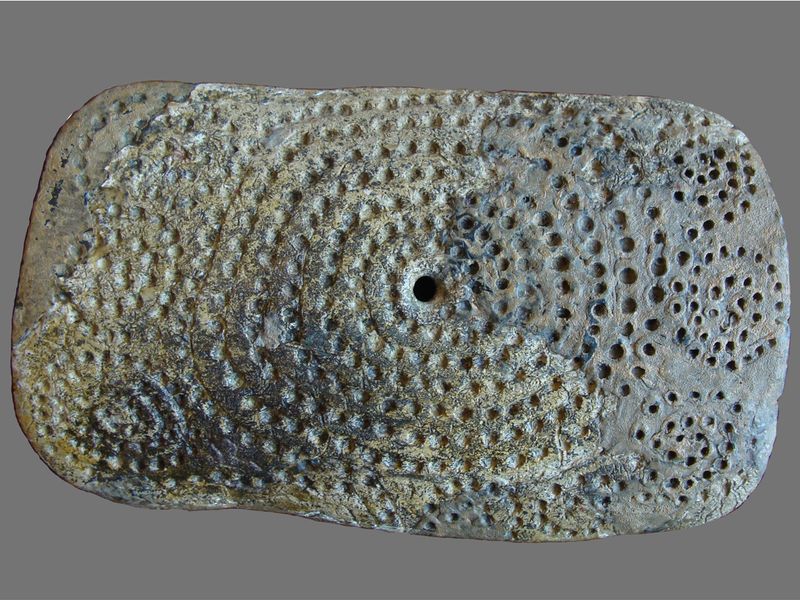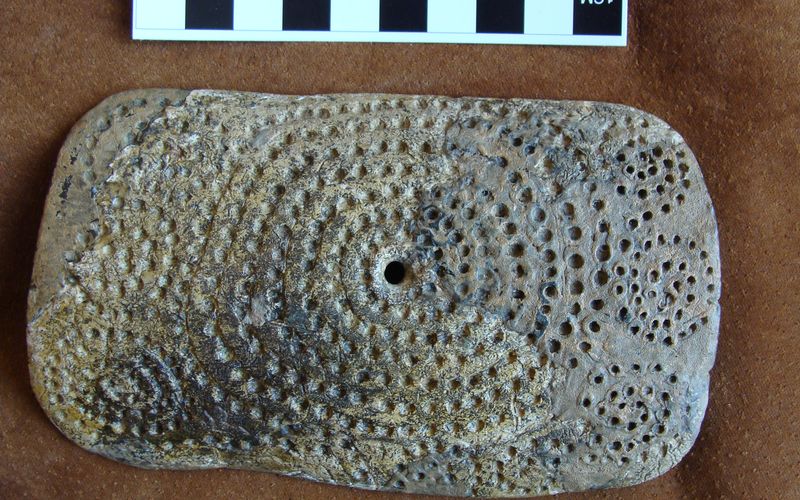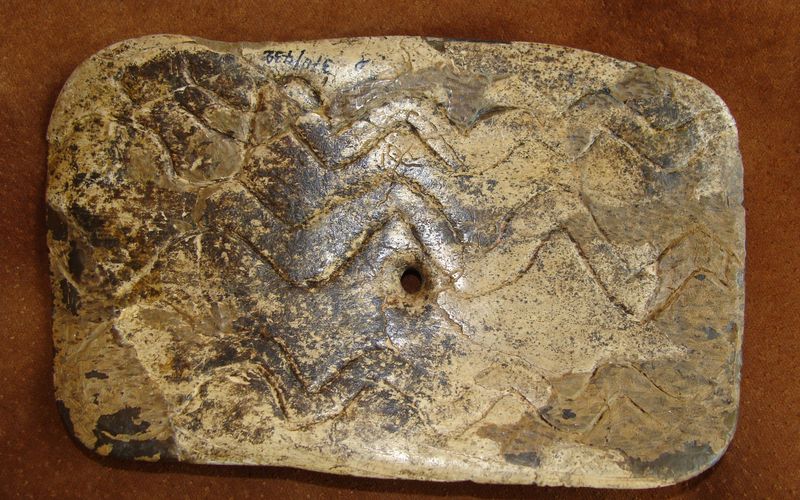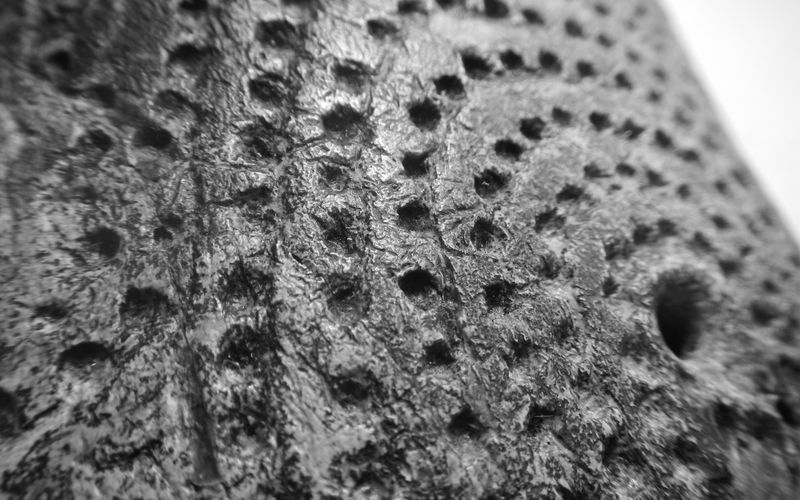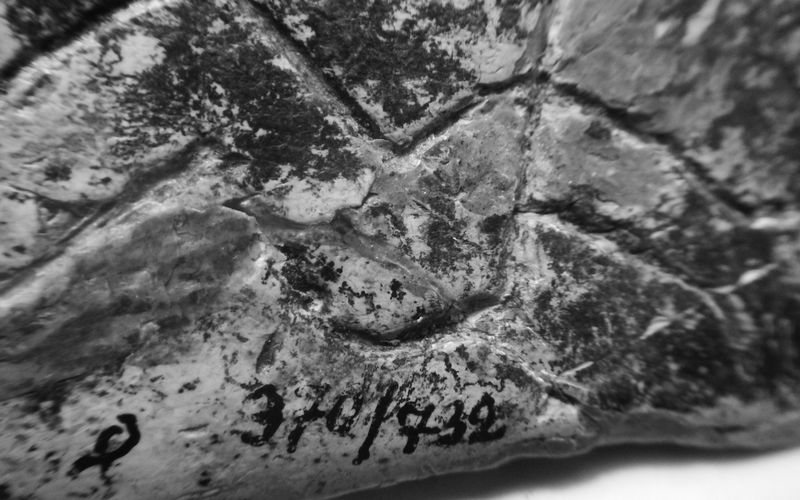Big Mal'ta plate
The outer side is covered with a typical Mal'ta ornament in the form of a several spirals made in rows of "cupulas". In the centre of the plate there is a large spiral which is accompined with two small spirals on both sides. The identical shapes are symmetrically depicted in each angle. In the lower angles of the plate (trapezium) there are ordinary spirals with one freely placed ending and one convoluted ending. In the top angles there are complex spirals, i.e., those with both endings convoluted in the shape of a capital letter S.
The concave side of the plate is decorated with three groups of wavy thin lines - images of, presumably, snakes. Moreover, two of them have their heads enlarged and resemble cobras with swollen hoods, the third is depicted in a quiescent statement. All the snakes are turned in one direction, and their wave-wriggling bodies are arranged in the entire length of the plate.
Manufacturing technique
The plate blank is slightly curved, the surface is overlapped with polishing. The marking of the plane with thin lines made with a cutting tool was previously done. The indentations were made with repeated rotational movement of a reamer to a relatively equal depth.The diameter of the bottom of the indentation is different, which could be due to the wearing of the tool. Cupula's configurations are different. Drilling was on a soft steamed material at a different angle to the main plane. Also, in the lower part, there are traces that are similar to the lines on the concave side of the plate. Probably the ornamentation of the item began from the central through-hole, which was made with biconical (two-sided) drilling with a reamer. Traces of polishing are found along the edges of the hole both on the outer and on the inner (concave) sides (flaring of the edge), i.e. the item was not rigidly fixed. Biconical drilling did not leave a cylindrical channel, it was erased, it is likely that the item rotated on the axis.
The concave side is polished. The contours of the image of "snakes" are made with a burin with intermittent movements at different depths, in some cases there traces of movement from oneself progressively. In some areas, there is a repeated passage of the lines.
Use-wear traces
There are no traces of hanging. The walls of the canals and the openings are smoothed, which may be the evidence of a contact with soft material. On the concave side, polishing is stronger, i.e. these side had more contacts with the soft surface than the outer one. Polishing recycling on the concave side is uneven, the most intensive area is along the edges of the item.
Storage location
The State Hermitage MuseumInventory number
370/732The Museum KAMIS
http://www.hermitagemuseum.org/wps/portal/hermitage/digital-collection/25.+archaeological+artifacts/1401495Size
Length - 146 mm
Width - 89 mm
Thickness - 12 mm
Material
IvoryDating
19-23 th years BPCulture
Mal'ta-Buret' archaeological cultureThe author of the excavations
Gerasimov M.M.1929
Publications
Gerasimov M.M. Malta. Paleoliticheskaya stoyanka (predvaritelnye dannie): rezultaty rabot 1928/29 g. - Ircutsk: Vlast' truda, 1931. - S. 16
Gerasimov M.M. Paleoliticheskaya stoyanka Mal'ta // Sov. ehtnografiya, 1958. № 3, S.39-43 (ris.11,g) (in Russ.)
Larichev V.E. Maltynskaya plastina iz bivnya mamonta. - Novosibirsk: Inst. istorii, filologii y filosofii, 1986. - 44 S.
Lbova L., Rostyazhenko T. Ornamental Artefacts as a Way to Transfer and Store Information in the Upper Palaeolithic: the Mal’ta Collection (Siberia) // Expression. – 2019. – Vol. 23. – P. 35-44
Kamenniy vek Uzhnogo Priangarya. Bel'skiy geoarheologicheskiy rayon. Irkutsk, 2001 - S. 82, 189
Rostyazhenko T.E. Maltinskiye ornamentirovannie diski kak predmety prestiga // Arheologia: Materialy 56-y Mezhdunar. nauch. stud. conf. 22-27 aprelya 2018 g. / Novosib. gos. un-t. - Novosibirsk: IPC NGU, 2018, S. 23-24
